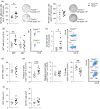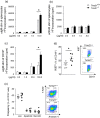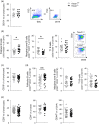The Sjögren's syndrome-associated autoantigen Ro52/TRIM21 modulates follicular B cell homeostasis and immunoglobulin production
- PMID: 30178506
- PMCID: PMC6230998
- DOI: 10.1111/cei.13211
The Sjögren's syndrome-associated autoantigen Ro52/TRIM21 modulates follicular B cell homeostasis and immunoglobulin production
Abstract
Systemic rheumatic diseases are characterized by abnormal B cell activation with autoantibody production and hypergammaglobulinaemia. Ro52/SSA, also denoted tripartite motif (TRIM)21, is a major autoantigen in Sjögren's syndrome and systemic lupus erythematosus. Interestingly, TRIM21-deficient mice develop systemic autoimmunity with B cell-driven manifestations such as autoantibodies, hypergammaglobulinaemia and glomerulonephritis following tissue injury. The mechanisms by which TRIM21-deficiency leads to enhanced B cell activation and antibody production are, however, not well understood, and to further elucidate the role of TRIM21 in systemic autoimmunity, we investigated the B cell phenotype and antibody responses of Trim21-/- mice following immunization with thymus-dependent (TD) and thymus-independent (TI) antigens. We found that TRIM21-deficient mice developed significantly higher specific antibody titres than their wild-type counterparts upon B cell receptor (BCR) engagement by TD and TI type II antigens, and this was accompanied by an altered B cell phenotype. Furthermore, BCR cross-linking, but not anti-CD40 stimulation, in vitro resulted in a significantly higher proliferation of Trim21-/- cells. We also observed that splenic follicular B cells were expanded not only in immunized mice but also already in young, unmanipulated Trim21-/- mice, and transcriptomic analysis of these cells revealed an up-regulation of genes associated with B cell differentiation, indicating a role for TRIM21 in their regulation. In conclusion, in this study we describe a link between the rheumatic autoantigen Ro52/TRIM21 and increased antibody production associated with follicular B cell expansion, implicating a potential role for Ro52/TRIM21 in the pathogenesis of systemic autoimmune diseases.
Keywords: B cell; Ro52; Sjögren’s syndrome; TRIM21; immunoglobulin.
© 2018 British Society for Immunology.
Figures






References
Publication types
MeSH terms
Substances
LinkOut - more resources
Full Text Sources
Other Literature Sources
Medical
Research Materials

